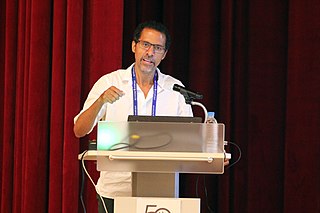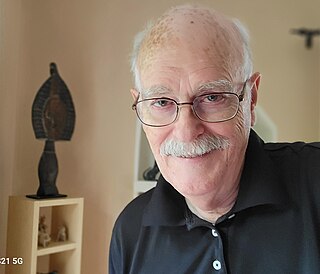Margaret Stratford Livingstone is the Takeda Professor of Neurobiology in the Department of Neurobiology at Harvard Medical School in the field of visual perception. She authored the book Vision and Art: The Biology of Seeing. She was elected a member of the American Academy of Arts and Sciences in 2015 and was elected to the National Academy of Sciences in 2020.

Adult neurogenesis is the process in which neurons are generated from neural stem cells in the adult. This process differs from prenatal neurogenesis.
The Lewis S. Rosenstiel Award for Distinguished Work in Basic Medical Research is awarded by Brandeis University. It was established in 1971 "as an expression of the conviction that educational institutions have an important role to play in the encouragement and development of basic science as it applies to medicine".
Elizabeth Gould is an American neuroscientist and the Dorman T. Warren Professor of Psychology at Princeton University. She was an early investigator of adult neurogenesis in the hippocampus, a research area that continues to be controversial. In November 2002, Discover magazine listed her as one of the 50 most important women scientists.

Nancy Gail Kanwisher FBA is the Walter A Rosenblith Professor of Cognitive Neuroscience in the Department of Brain and Cognitive Sciences at the Massachusetts Institute of Technology and a researcher at the McGovern Institute for Brain Research. She studies the neural and cognitive mechanisms underlying human visual perception and cognition.
Neuropoiesis is the process by which neural stem cells differentiate to form mature neurons, astrocytes, and oligodendrocytes in the adult mammal. This process is also referred to as adult neurogenesis.

HVC is a nucleus in the brain of the songbirds necessary for both the learning and the production of bird song. It is located in the lateral caudal nidopallium and has projections to both the direct and the anterior forebrain pathways.

Pasko Rakic is a Yugoslav-born American neuroscientist, who presently works in the Yale School of Medicine Department of Neuroscience in New Haven, Connecticut. His main research interest is in the development and evolution of the human brain. He was the founder and served as Chairman of the Department of Neurobiology at Yale, and was founder and Director of the Kavli Institute for Neuroscience. He is best known for elucidating the mechanisms involved in development and evolution of the cerebral cortex. In 2008, Rakic shared the inaugural Kavli Prize in Neuroscience. He is currently the Dorys McConell Duberg Professor of Neuroscience, leads an active research laboratory, and serves on Advisory Boards and Scientific Councils of a number of Institutions and Research Foundations.

Bruce Sherman McEwen was an American neuroendocrinologist and head of the Harold and Margaret Milliken Hatch Laboratory of Neuroendocrinology at Rockefeller University. He was known for his work on the effects of environmental and psychological stress, having coined the term allostatic load.

Erich Jarvis is an American professor at Rockefeller University. He is the head of a team of researchers who study the neurobiology of vocal learning, a critical behavioral substrate for spoken language. By studying animals including songbirds, parrots, and hummingbirds, his research attempts to show that bird groups have similar learning abilities to humans in the context of sound, such as learning new sounds and then passing on vocal repertoires from one generation to the next. Jarvis focuses on the molecular pathways involved in the perception and production of learned vocalizations, and the development of brain circuits for vocal learning.
The Gruber Prize in Neuroscience, established in 2004, is one of three international awards worth US$500,000 made by the Gruber Foundation, a non-profit organization based in Yale University in New Haven, Connecticut.

Cornelia Isabella "Cori" Bargmann is an American neurobiologist. She is known for her work on the genetic and neural circuit mechanisms of behavior using C. elegans, particularly the mechanisms of olfaction in the worm. She has been elected to the National Academy of Sciences and had been a Howard Hughes Medical Institute investigator at UCSF and then Rockefeller University from 1995 to 2016. She was the Head of Science at the Chan Zuckerberg Initiative from 2016 to 2022. In 2012 she was awarded the $1 million Kavli Prize, and in 2013 the $3 million Breakthrough Prize in Life Sciences.
Lawrence C. Katz was an American neurobiologist. He was an investigator at the Howard Hughes Medical Institute. His lab was located in Duke University Medical Center, where he was the James B. Duke Professor of Neurobiology.
Masakazu "Mark" Konishi was a Japanese neurobiologist, known for his research on the neuroscience underlying the behavior of owls and songbirds.
Christine Elizabeth Holt is a British developmental neuroscientist.
Peter Robert Marler ForMemRS was a British-born American ethologist and zoosemiotician known for his research on animal sign communication and the science of bird song. A 1964 Guggenheim Fellow, he was emeritus professor of neurobiology, physiology and ethology at the University of California, Davis.

Donald Eugene Kroodsma is an American author and ornithologist, one of the world's leading experts on the science of birdsong.
Steven A. Goldman is an American physician-scientist. His research focuses on the use of stem and progenitor cells for the treatment of neurodegenerative disorders such as Huntington's Disease, as well as for the treatment of glial diseases such as the pediatric leukodystrophies and multiple sclerosis.
HollisT. Cline is an American neuroscientist and the Director of the Dorris Neuroscience Center at the Scripps Research Institute in California. Her research focuses on the impact of sensory experience on brain development and plasticity.

Arthur Palmer Arnold is an American biologist who specializes in sex differences in physiology and disease, genetics, neuroendocrinology, and behavior. He is Distinguished Professor of Integrative Biology & Physiology at the University of California, Los Angeles (UCLA). His research has included the discovery of large structural sex differences in the central nervous system, and he studies of how gonadal hormones and sex chromosome genes cause sex differences in numerous tissues. His research program has suggested revisions to concepts of mammalian sexual differentiation and forms a foundation for understanding sex difference in disease. Arnold was born in Philadelphia.








